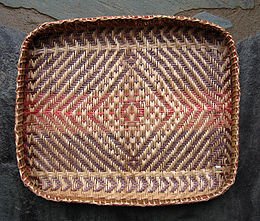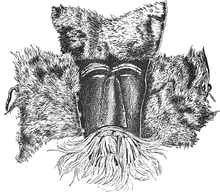- Cherokee society
-
 Little Miss Cherokee 2007, Park Hill, Oklahoma
Little Miss Cherokee 2007, Park Hill, Oklahoma
 Cherokee artist and ethnobotanist, Roger Cain of Stilwell, Oklahoma, explains Cherokee masks, 2007. The mask on the left is a Booger Mask.
Cherokee artist and ethnobotanist, Roger Cain of Stilwell, Oklahoma, explains Cherokee masks, 2007. The mask on the left is a Booger Mask.
Cherokee society refers to the society and culture of the Cherokee (or ᎠᏂᏴᏫᏯᎢ (a-ni-yv-wi-ya-i) in Cherokee language) people. The Cherokee are a people native to North America who at the time of European contact in the 16th century inhabited what is now the eastern and southeastern United States before the majority of the tribe was forcefully moved to Indian Territory.
Cherokee society was traditionally organized into seven clans, with Cherokee villages having two governmental units (with one government handling affairs in peacetime and the other during times of war) and a medicine chief who would resolve disputes between the Red Chief and White Chief should they disagree. Family was also central to Cherokee society. During the year, the Cherokee celebrated the Cherokee Moons Ceremonies.
The capital of the Cherokee Nation and the United Keetoowah Band of Cherokee Indians is Tahlequah, Oklahoma. According to local legends, after the arrival of the Cherokee on the Trail of Tears, the three chiefs of the Cherokee People (Red Chief, White Chief, and the Medicine Chief) had scheduled a rendezvous near present day Tahlequah in order to select a site to settle and use as the seat of local government. When they arrived at the site of present day Tahle-quah, only two of the three chiefs arrived on time. After waiting for the third chief to arrive and gain consensus, the two chiefs went ahead and approved the site and named it "Tahle-quah". In Cherokee, "Tahle" represents the number two and "quah" means "it's enough", or translated as "Two is enough", indicating the two chiefs present constituted a quorum and felt they could make the decision on the townsite for the Cherokee Nation Capitol without waiting for the third chief to arrive. The legend does not state which of the three chiefs were not present, but it was believed to have been the White Chief who was late.[citation needed]
Contents
The seven Cherokee Clans
Main article: Cherokee ClansAncient Cherokee or Ah-ni-yv-wi-ya society was traditionally grouped around a social organization of seven clans. These were:
- Blue (also Panther or Wild Cat) Clan (ᎠᏂᏌᎰᏂ (a-ni-sa-ho-ni) in Cherokee) made a medicine from a bluish colored plant called the Cherokee black drink for purification ceremonies.
- Long Hair (also Twister, Hair Hanging Down, or Wind) Clan (ᎠᏂᎩᎶᎯ (ah-ni-gi-lo-hi) in Cherokee) wore their hair in elaborate hairdos, walked in a proud and vain manner twisting their shoulders.[citation needed] The Peace Chief was usually from this clan.
- Bird Clan (ᎠᏂᏥᏍᏆ (a-ni-tsi-s-qua) in Cherokee) were the keepers of the birds, skilled in using blowguns and snares for bird hunting.
- Paint Clan (ᎠᏂᏬᏗ (a-ni-wo-di) in Cherokee) made red paint and gathered the sacred colors used in the ceremonies.
- Deer Clan (ᎠᏂᎠᏫ (a-ni-a-wi) in Cherokee) were the keepers of the deer and were known as fast runners and deer hunters.
- Wild Potato (also Bear, Raccoon, or Blind Savannah) Clan (ᎠᏂᎦᏙᎨᏫ (a-ni-ga-do-ge-wi) in Cherokee) gathered the wild potato in swamps along streams for food.
- Wolf Clan (ᎠᏂᏩᏯ (a-ni-wa-ya) in Cherokee) was the largest and most prominent clan providing most of the tribe's war chiefs. They were keepers of the wolf and the only clan who could kill a wolf.
The number "seven" was sacred to the Cherokee from ancient times. It represented the seven levels of spiritual attainment and the seven levels of material manifestation in the world of the Cherokee.[citation needed] It also represented the seven levels of the universe in Cherokee spiritual beliefs. The Cherokee had a matrilineal society, a social system in which their descent was traced strictly through their mother's side of the family. The most important man in the life of any Cherokee child was their mother's brother. Discipline and instruction in hunting and warfare rested not with the child's father, but with his maternal uncle.
The clan provided many important functions including care for orphans and the destitute, and hospitality for visiting clan members from other towns. This practice was referred to as Gadugi in ancient times.[citation needed]
Blood revenge
The blood revenge custom, an ancient Ah-ni-ku-ta-ni belief, was usually made by an older male of the victim's clan if it could not be taken by his oldest brother. The Cherokees believed that balance had to be restored in order to preserve the balance of forces between the two worlds, the spirit world, and the world of physical reality, and to free the soul of the victim and to let it pass from this world to the next. (It was the practice to avenge the victim by taking the life of the murderer himself, however, a close relative of the murderer would satisfy the revenge.) The Ancient Law of Blood Revenge was abolished by the Cherokee National Government on September 11, 1808. This act of abolishment was seen to have advanced the Cherokees in civilization, and it was universally accepted by the Cherokee People.[citation needed]
The Council House
The Council House was seven-sided and provided seven sections of seats within, giving each clan a section for its representatives within the governmental structure. The seven sections of seats surrounded the sacred fire.
Villages
 Rivercane basket with Noon-day Sun pattern, by Peggy Brennan (Cherokee Nation)
Rivercane basket with Noon-day Sun pattern, by Peggy Brennan (Cherokee Nation)
Each village of the Cherokees had two governmental units: a white and red government. During times of peace the white government had complete control of all affairs dealing with the village. This government consisted of older and wiser men who would not make foolish decisions. In times of war all duties fell on the red government which consisted of younger men who would do well in battle. There was also a Medicine Chief who would break the tie during voting when the Red Chief and White Chief could not agree on an issue.[citation needed]
White government
The white government consisted of the Chief of the tribe, the chief's right-hand man, prime counselors (one from each clan unit), a council of elders, a chief speaker, and a Council of Grandfathers. This is the organization that made the decisions which affected the tribe during their times of peace.[citation needed]
Red government
The red government consisted of a Great Red War Chief, The Great War Chief's Second, seven War Counselors, the Chief War Speaker, Messengers, Ceremonial Officers and War Scouts. The seven war counselors were in charge of declaring war when they felt the circumstances made it necessary. The Council of Grandmothers would declare the fate of captives and prisoners that were taken in times of war.[citation needed]
Naming
The father of a Cherokee and the ranking grandmother of the father's clan had the right in traditional Cherokee society to name any children born of a Cherokee marriage. The ceremony was typically performed within seven days of birth and the child was taken to a running body of water, and the seven places ceremonially washed with water.[citation needed]
Traditional use of masks
The Cherokee used masks in numerous dances. One such dance, known as "The Booger Dance", was usually performed in the late fall or winter. The Booger masks were made to represent the faces of Indian tribes who were the enemies of the Cherokee. After the arrival of Europeans, Booger Masks began to appear with large eyebrows, mustaches, beards, and bald heads, similar to the appearance of Europeans.
The Booger Masks were made from large gourds, hornets nests, buckeye, or poplar wood. Booger Masks have become increasingly plentiful in modern times and are mass produced and sold to tourists in Cherokee, North Carolina which explains their pervasiveness and popularity[clarification needed].
The Bear Dance, Beaver Dance, and Forest Buffalo Dances also employed masks.[citation needed] Buffalo masks were typically fashioned from Buckeye wood. Both Bear and Beaver masks were made from the fur hides of each animal and were worn loosely or sewn.
See also
Notes
References
- Garrett, J.T. and Michael Tlansusta. The Cherokee Full Circle. Bear & Company. ISBN 1-879181-95-9.
- Reed, Marcelina. Seven Clans of the Cherokee Society. Cherokee Publications. First Edition, ISBN 0-935741-17-8.
External links
Categories:- Cherokee tribe
Wikimedia Foundation. 2010.


